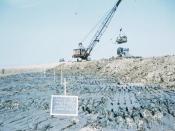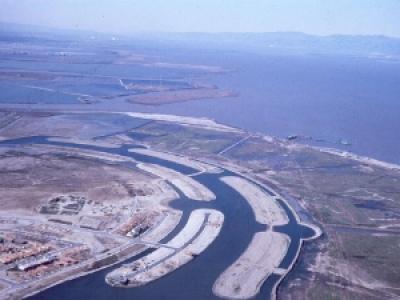The Creation of Foster City - Land
Creating the Land
Foster and Grant chose Brewer's Island, owned at the time by Leslie Salt Company and the Schilling Estate, to develop this progressive new city. Brewer's Island presented some severe drawbacks to development, foremost of which was the quality of the land itself. The area of Brewer's Island was originally San Francisco Bay salt marsh tideland, but it had been dry and protected from the Bay since 1897 or earlier. Records decisively established the land as dry and used for dairy purposes on March 17,1898. San Mateo County Reclamation District allowed Brewer to establish even more dikes along the Bay, reportedly built by the Peabody Dredging Company, around 1901.
Once the Bay was diked off with levees the land was left to dry into a silty clay mud. After the turn of the century this land became known as Frank M. Brewer's dairy farm, complete with cows and hay fields. Brewer's dairy farm covered 2,200 acres and adjacent salt ponds covered another 550 acres.
The levees were strengthened between 1947 and 1960, and continued strengthening (by Cal Trans) occurred as recently as 1983. These levees are still considered to be of excellent construction and strength, despite their age.
In the documents section below is a historical evaluation of Foster City and the levee system conducted in 2016 as part of the Environmental Impact Report for the Foster City Levee Protection and Improvements Project.

As a former tideland, Brewer's Island was situated at mean sea level. This presented the enormous problem of raising the elevation of the island to provide drainage gradient and prevent flooding. Additionally, the soft mud needed to be strengthened to support buildings. The initial Army Corps of Engineers evaluation stated that the island would necessitate a landfill operation to bring surface elevations up to between 8 and 12 feet. San Mateo County Engineer Don Wilson concurred with this estimate. Such a landfill operation would have required 45 million cubic yards of material, which in turn would have created settlement depressions several feet deep in the soft silty mud of the island.
The local engineering firm of Wilsey and Ham eventually found a satisfactory solution to the drainage dilemma. The basic idea was simply to raise the surface elevation 4 to 5 feet, and to create a central drainage basin, a water "impoundment area," resembling a lake or lagoon in the middle of the city, which could then be pumped back into the Bay. As an added bonus, the aesthetic quality of the lagoon enhanced the overall attractiveness of the planned city.
The pumping operation lasted six years -- 24 hours per day, seven days per week. On average, 6.4 thousand cubic yards of sand were pumped up from San Francisco Bay (at San Bruno Shoal) for deposit on Brewer's Island daily- a total deposit of more than 14 million cubic yards of material.
